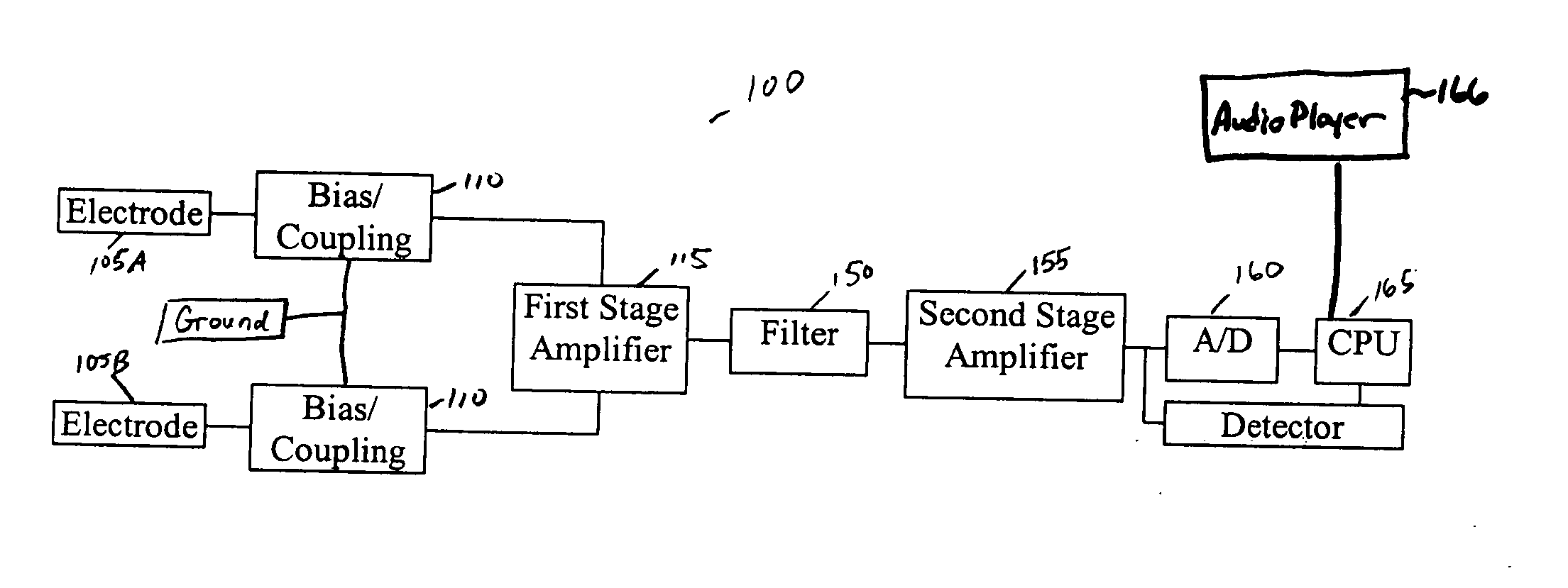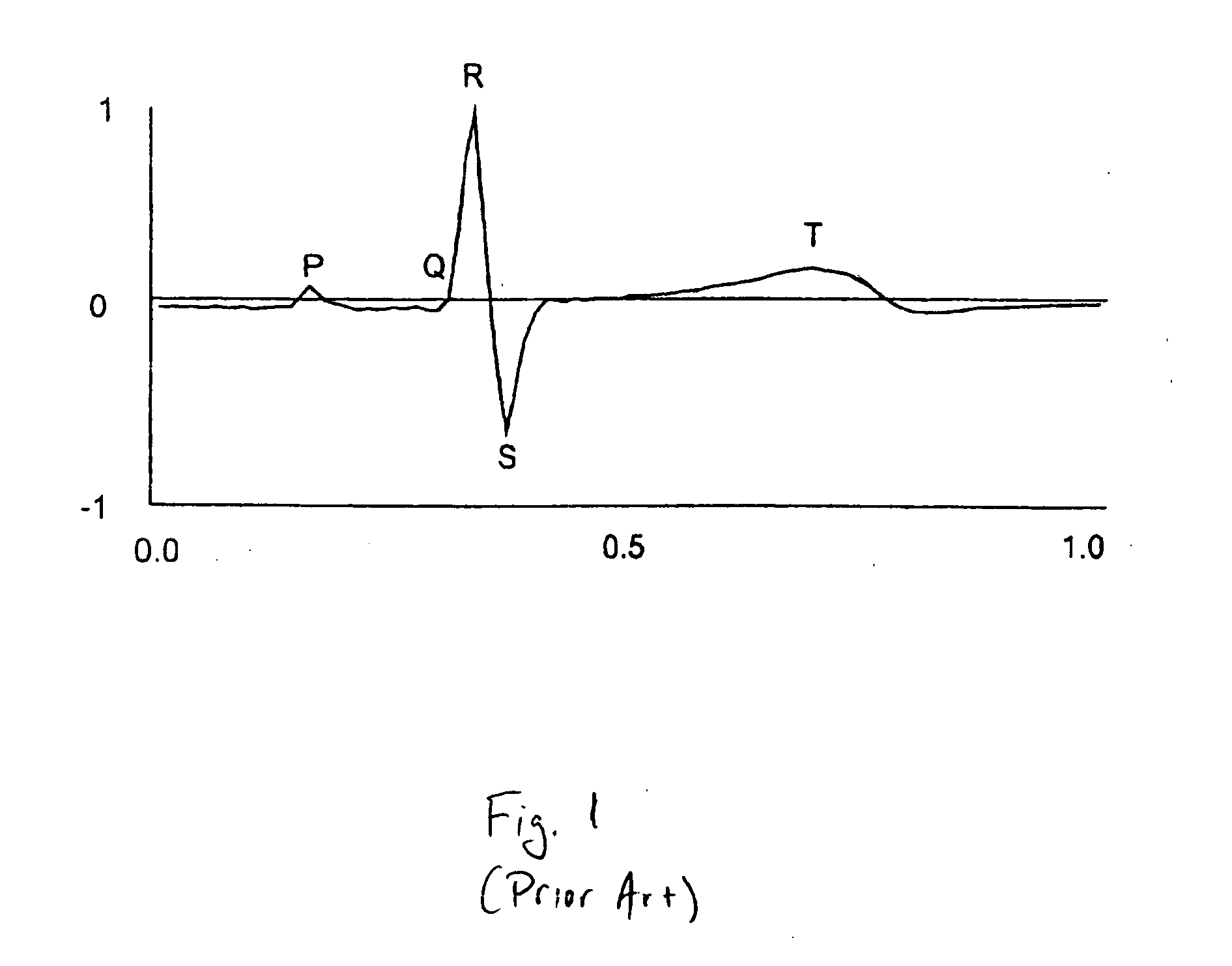[0022] A monitor device and associated methodology are disclosed which provide a self contained, relatively small and wearable
package for the monitoring of heart related parameters, including ECG. The monitor device is primarily a simple, unobtrusive housing which is wearable in the sense that it is temporarily affixed to the user's body, but also wearable in the sense described in Stivoric, et al., U.S. Pat. No. 6,527,711, issued Mar. 4, 2003, the disclosure of which is incorporated by reference hereto. Stivoric teaches that the
sizing, flexibility and location of items attached to the body significantly affect the ability of the wearer to recognize the item as part of the body, reducing the
irritation factor associated with wearing such an item for extended periods of time. Furthermore, the use of the appropriate shapes, materials and locations reduces the interference of the item with normal
body movement and activity. Each of these factors increases the wearability of the item and therefore increases the compliance of the wearer with the need for long term and continuous wear.
[0023] More specifically, the monitor device may be of a type described in Teller, et al., U.S. Pat. No. 6,605,038, issued Aug. 12, 2003, the specification of which is incorporated herein by reference. The primary focus of the monitor device itself is to provide the functionality described below in a housing or other
package which is comfortable for long term wear, remains in place during normal daily activity so as to continuously provide a quality
signal or data
record and also reduces the
noise or other interference to that
signal or
record created by the device itself. One focus of the device is to provide a self-contained housing which incorporates all or at least the majority of the operating hardware. The monitor device, in addition to the Teller device, may further include, as an accessory or rigid housing substitute, a large sized
adhesive strip, similar to that used for cuts and abrasions which contains the sensor package within the current location of the
absorbent material. Reduction of weight and bulk is very important to increasing the ability for the device to remain affixed in both the right location and with proper contact to the body, especially under rigorous conditions, such as exercise. The device is easy to put on and take off without need for extensive or clinical
skin preparation, if any. The device is provided with an appropriate type and strength of
adhesive required to keep the weight of the device from disconnecting any snaps or other connections, or pulling the
electrode off of the
skin. One primary
advantage of the device is the
elimination of long lead wires which, in addition to being unsightly and inconvenient, act as large antennas for creating
noise input to the
system. Reduction in the amount of snap connections also reduces these noises, which are common for Holter and loop devices. While not necessarily possible with the current state of processor and sensor size, it is clearly contemplated that the instant
system, given the appropriate
miniaturization of hardware, could be as simple as sliding on a watch or pair of glasses, utilizing the same basic methodology and equipment identified herein.
[0030] The system is designed to collect data continuously, with no interaction of the wearer necessary, but such interaction is permitted for additional functionality such as particular
time stamping capabilities, as necessary. The ability to continuously monitor the heart related parameters limits the need for a manual trigger at the time of an event or the detection of a threshold condition based upon the status of the
derived data, as described above. While the system is designed to collect data continuously, in some embodiments the user may utilize the
timestamp button to
signal that certain
heart rate parameters should be collected for the time period around the
timestamp. An additional functionality of the device is context and
activity detection. Through the use of both the physiological and contextual sensors provided in the device, the ability to learn, model, or ascertain what combinations of data parameters relate to certain activities can be achieved. The ability to detect and discern the type of activity in which the user is engaged relieves the user of the need to manually log these activities to correlate with the heart output data during subsequent review.
[0033] Additionally, the device may be combined with other like devices in a cooperative array, which may be utilized to further process or analyze the signals derived therefrom. For example, in the case of a pregnant woman, a first such device may be positioned to detect the mother's heart related parameters in a location unlikely to detect the
fetal heart related parameters and a second such device, especially in the form of an
adhesive or other patch, might be located immediately adjacent the
fetus on the mother's
abdomen. The signals from the mother's device could be utilized to eliminate the
noise of the mother's heart related parameters from the
fetus'
data stream.
[0034] Feedback from the system can take many forms, including the standard visual graphical methods, but a preferred embodiment would include
audio feedback as well. This audio component may be in the form of a sound that resonates / conducts through the body, like a bone phone or other variant, to make this feeling more intimate and body like, even if the sound is manufactured digitally to represent the beat. A digital or analog
stethoscope could be included in the system to assist in the production of an appropriate sound. Such a device on the
abdomen could alternatively be made up of an array of Doppler or ECG electrodes to reduce the need to search for the most appropriate signal location. The device may also be adapted to work in conjunction with an implantable device or other consumed data
detector.
 Login to View More
Login to View More  Login to View More
Login to View More 


